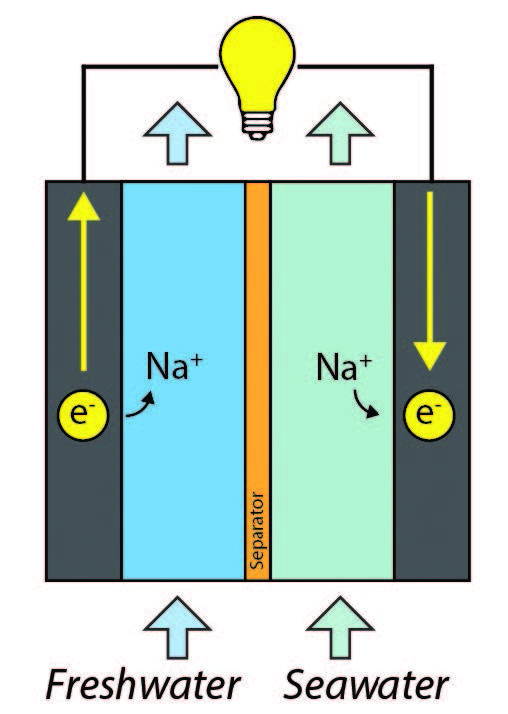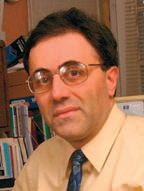New approach to generate power from salinity differences in water
Dr. Neil Canter, Contributing Editor | TLT Tech Beat December 2016
A new CapMix technique produces an average power density higher than what was previously reported.
KEY CONCEPTS
•
Mixing two water sources with different salinity contents leads to the generation of energy through an increase in entropy.
•
The energy is captured electrochemically through a number of processes including capacitive mixing.
•
A concentration flow cell developed through a new capacitive mixing approach generates an average power density that is double previously reported levels.
A NUMBER OF TECHNOLOGIES ARE UNDER DEVELOPMENT to use our natural resources to generate electricity. Among the approaches that have been discussed in this column are solar energy, wind energy and even human body heat on a small scale to power electronic devices.
One other idea uses the differences in salt concentration (salinity) in various water sources. Fresh water with low salinity and seawater with high salinity are readily available.
In a previous TLT column, the salinity difference between fresh water and seawater was used in a technique known as pressure-retarded osmosis to generate electricity by forcing water from a less salty source to pass through a membrane to a saltier source under pressure (
1). One conclusion from this research was that 95% of the maximum power can be generated using 50% or less of the maximum semi-permeable membrane area.
The reason that power can be generated from water sources with high and low salinity is due to entropy. Christopher Gorski, assistant professor in civil and environmental engineering at Pennsylvania State University in University Park, Pa., says, “Energy is gained by mixing two water sources with different salinity levels due to the increase in entropy realized in the process. Typically the energy generated is released as heat, but it can be captured electrochemically through processes that are efficient and quick.”
Besides pressure-retarded osmosis, other methods to use salinity difference include reverse electrodialysis and capacitive mixing (CapMix). Gorski says, “The problem with these techniques is cost and power density. The cost involves how much electricity can be produced per dollar spent. The power density focuses on how much electrical power can be generated per unit area on an electrode or membrane. Past methods have been too inefficient.”
Gorski considers CapMix to be a promising technology because it can be accomplished in a cost-efficient manner. He says, “Pressure-retarded osmosis uses hydraulic pressure to generate power, which can be expensive. The other way to take advantage of water salinity differences is to use an electrochemical process. Reverse electrodialysis generates a voltage across a membrane, but this also can be expensive because ion selective membranes are very costly.”
A second electrochemical method is to generate voltage at the electrode surface. The challenge is to find a way for the electrode reaction to go quickly. Gorski and his colleagues have now developed a technique that produces an average power density higher than any other CapMix device reported in the literature.
CONCENTRATION FLOW CELL
The researchers developed a concentration flow cell using information learned in past studies. Two battery electrodes prepared from nontoxic copper hexacyanoferrate are used and are separated by only 200 microns instead of millimeters. An inexpensive (nonselective) filtration membrane is placed between the two electrodes.
Gorski says, “We shrank the flow cell down to a narrow system in order to minimize resistance that can lead to energy loss. After surveying all potential electrode materials available, we selected copper hexacyanoferrate because of its lack of toxicity and its fast charge/discharge cycle that lasts only 60 seconds. In contrast, materials such as magnesium oxide can require up to 20-30 minutes to complete one cycle.”
Figure 2 shows a schematic of the concentration flow cell where water with a high salinity content flows past one electrode while water with a low salinity content flows past the second electrode. An electrochemical potential is produced in the charging process. During the discharge phase, sodium ions present at a high concentration in the high-salinity water reduce the electrode material while sodium ions are released at the other electrode into the low salinity water where oxidation is occurring. Once the voltage between the electrodes reaches a value near to zero, the solutions are flipped to regenerate the electric potential.
 Figure 2. The salinity content difference between water with a high salinity content and a low salinity content is used to produce power in the concentration flow cell shown. (Figure courtesy of Pennsylvania State University.)
Figure 2. The salinity content difference between water with a high salinity content and a low salinity content is used to produce power in the concentration flow cell shown. (Figure courtesy of Pennsylvania State University.)
The researchers are able to achieve an average power density of 411 milliwatts per square meter that is more than double what was previously reported. One of the challenges facing the researchers is finding the right hydraulic retention time to maximize performance. Gorski says, “Too slow a retention time will lead to a loss of energy while too fast a retention time means more energy is needed to use the pump to move water across the membrane. The important issue is not to lose the gradient balance developed between the two water sources.”
In future work, the researchers are looking to reduce the resistance found in the concentration flow cell to improve efficiency. Gorski says, “We will be evaluating different electrode materials and also try to further reduce the distance between electrodes.”
A recent development soon to be reported by the researchers is the benefit found in combining ion selective membranes with a battery-electrode-based system. Gorski says, “Our preliminary results have shown that we can increase the power density of the system using this approach by a factor of 10 to five watts per square meter.
Additional information on this work can be found in a recent article (
2) or by contacting Gorski at
gorski@psu.edu.
REFERENCES
1.
Canter, N. (2014), “Power generation using pressure-retarded osmosis,” TLT,
70 (11), pp. 10-11.
2.
Kim, T., Rahimi, M., Logan, B. and Gorski, C. (2016), “Harvesting energy from salinity differences using battery electrodes in a concentration flow cell,”
Environmental Science & Technology,
50 (17), pp. 9791-9797.
 Neil Canter heads his own consulting company, Chemical Solutions, in Willow Grove, Pa. Ideas for Tech Beat items can be sent to him at neilcanter@comcast.net
Neil Canter heads his own consulting company, Chemical Solutions, in Willow Grove, Pa. Ideas for Tech Beat items can be sent to him at neilcanter@comcast.net.